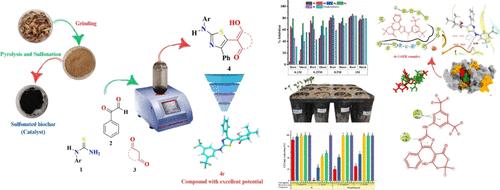可持续碳质催化剂多组分合成2,4,5-三取代噻唑及其除草抑菌潜力评价
IF 6.2
1区 农林科学
Q1 AGRICULTURE, MULTIDISCIPLINARY
引用次数: 0
摘要
本文提出了一种新的、生物催化的、水上微波辅助的多组分方法来合成三取代噻唑(4a-4v)。采用磺化花生壳渣衍生碳质催化剂(SPWB)催化反应。采用傅里叶变换红外(FTIR)、布鲁诺尔-埃米特-泰勒(BET)表面积分析仪、场发射扫描电镜(FE-SEM)、能量色散x射线(EDX)和粒度分析仪(PSA)对催化剂进行了表征。用酸碱反滴定法确定了酸性位点。所有合成化合物的分子结构通过FT-IR、1H NMR、13C NMR、元素和HRMS分析进行了验证。以莴苣(Raphanus sativus L.)为模型,评价其除草潜力。此外,噻唑对金黄色葡萄球菌、枯草芽孢杆菌、油菜黄单胞菌、大肠杆菌、黄体微球菌和铜绿假单胞菌的抑菌潜力进行了评价。化合物4r对Raphanus sativus L.的种子生长抑制作用优于市售除草剂,即戊二甲基灵。抑菌活性良好(MIC: 4 ~ 64 μg/mL)。化合物4r对铜绿假单胞菌(P. aeruginosa)和金黄色葡萄球菌(S. aureus)的抑制效果(MIC: 0.0076 μM)优于标准药物链霉素(MIC: 0.0138 μM)。此外,用最有效的化合物4r对铜绿假单胞菌进行的计算机研究揭示了其在蛋白质结合口袋内的潜在结合模式。生物学数据显示化合物4r是开发高效除草和抗菌药物的潜在候选者。综上所述,本研究提供了花生壳生物废弃物作为多相酸催化剂制备及其在多组分生物活性噻唑合成中的应用的可持续生物质,符合可持续发展目标和循环生物经济的理念。本文章由计算机程序翻译,如有差异,请以英文原文为准。

Multicomponent Synthesis of 2,4,5-Trisubstituted Thiazoles Using a Sustainable Carbonaceous Catalyst and Assessment of Its Herbicidal and Antibacterial Potential
Herein, a novel, biocatalyzed, and on-water microwave-assisted multicomponent methodology have been developed for the synthesis of trisubstituted thiazoles (4a–4v). The reaction was catalyzed using a sulfonated peanut shell residue-derived carbonaceous catalyst (SPWB). The developed catalyst was characterized using Fourier transform infrared (FTIR), a Brunauer–Emmett–Teller (BET) surface area analyzer, a field emission scanning electron microscope (FE-SEM), energy-dispersive X-ray (EDX), and a particle size analyzer (PSA). The acidic sites have been established using acid–base back-titration methods. The molecular structures of all the synthesized compounds were validated using FT-IR, 1H NMR, 13C NMR, elemental, and HRMS analyses. Herbicidal potential was evaluated by using Raphanus sativus L. as a model. Furthermore, the antibacterial potential of thiazoles was evaluated against Staphylococcus aureus, Bacillus subtilis, Xanthomonas campestris, Escherichia coli, Micrococcus luteus, and Pseudomonas aeruginosa bacterial strains. The compound 4r displayed improved seed growth inhibition in Raphanus sativus L. versus a commercially available herbicide, i.e., pendimethalin. The antibacterial activity was promising against bacterial strains (MIC: 4–64 μg/mL). The compound 4r was the most potent against P. aeruginosa and S. aureus (MIC: 0.0076 μM) versus standard drug streptomycin (MIC: 0.0138 μM). Moreover, in silico studies performed with the most effective compound 4r against P. aeruginosa revealed its potential binding mode within the protein binding pocket. The biological data revealed compound 4r as a potential candidate for the development of potent herbicidal and antibacterial agents. In a nutshell, this study offers peanut shell biowaste to be a sustainable biomass for heterogeneous acid catalyst preparation and its application in the multicomponent synthesis of bioactive thiazoles, accommodating the concept of sustainable development goals and circular bioeconomy.
求助全文
通过发布文献求助,成功后即可免费获取论文全文。
去求助
来源期刊
CiteScore
9.90
自引率
8.20%
发文量
1375
审稿时长
2.3 months
期刊介绍:
The Journal of Agricultural and Food Chemistry publishes high-quality, cutting edge original research representing complete studies and research advances dealing with the chemistry and biochemistry of agriculture and food. The Journal also encourages papers with chemistry and/or biochemistry as a major component combined with biological/sensory/nutritional/toxicological evaluation related to agriculture and/or food.

 求助内容:
求助内容: 应助结果提醒方式:
应助结果提醒方式:


